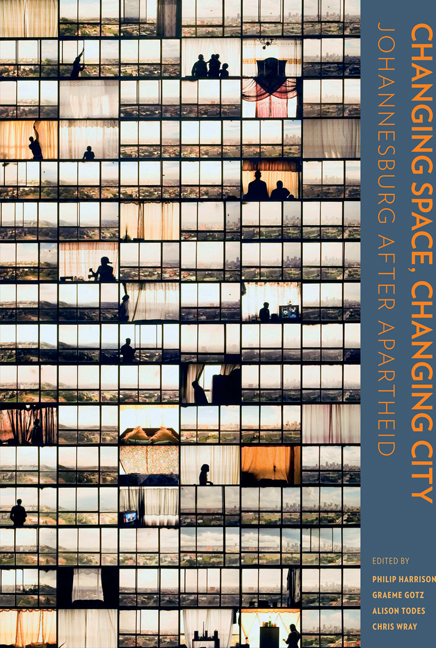Book contents
- Frontmatter
- Contents
- Preface
- Cartography
- 1 Materialities, subjectivities and spatial transformation in Johannesburg
- Section A The macro trends
- 2 The ‘thin oil of urbanisation’? Spatial change in Johannesburg and the Gauteng city-region
- 3 Poverty and inequality in the Gauteng city-region
- 4 The impact of policy and strategic spatial planning
- 5 Tracking changes in the urban built environment: An emerging perspective from the City of Johannesburg
- 6 Johannesburg's urban space economy
- 7 Changes in the natural landscape
- 8 Informal settlements
- 9 Public housing in Johannesburg
- 10 Transport in the shaping of space
- 11 Gated communities and spatial transformation in Greater Johannesburg
- Section B Area-based transformations
- Section C Spatial identities
- Contributors
- Photographic credits
- Acronyms
- List of plates
- List of figures
- List of tables
- Index
5 - Tracking changes in the urban built environment: An emerging perspective from the City of Johannesburg
from Section A - The macro trends
Published online by Cambridge University Press: 20 April 2018
- Frontmatter
- Contents
- Preface
- Cartography
- 1 Materialities, subjectivities and spatial transformation in Johannesburg
- Section A The macro trends
- 2 The ‘thin oil of urbanisation’? Spatial change in Johannesburg and the Gauteng city-region
- 3 Poverty and inequality in the Gauteng city-region
- 4 The impact of policy and strategic spatial planning
- 5 Tracking changes in the urban built environment: An emerging perspective from the City of Johannesburg
- 6 Johannesburg's urban space economy
- 7 Changes in the natural landscape
- 8 Informal settlements
- 9 Public housing in Johannesburg
- 10 Transport in the shaping of space
- 11 Gated communities and spatial transformation in Greater Johannesburg
- Section B Area-based transformations
- Section C Spatial identities
- Contributors
- Photographic credits
- Acronyms
- List of plates
- List of figures
- List of tables
- Index
Summary
Change within the urban environment remains a constant. In South Africa, the primary question since 1994 has been how the forces and drivers of change can be guided in ways that address the multitude of challenges facing a fledgling democracy. The scale and nature of change in the built environment impact significantly on the public and private sectors, informing and shaping their future policies and investment strategies. However, while both sectors play significant roles in investment and in shaping urban form and fabric, the two are not necessarily aligned. As the primary arbiter of development and associated changes to their urban environments, municipalities in South Africa have a fundamental obligation to manage and direct change.
In Chapter 4, Alison Todes provided an overview of the spatial policies and frameworks that have been put in place to guide development in Johannesburg. In this chapter we examine the extent to which the objectives of these spatial plans are being realised by drawing on data from the system established by the City of Johannesburg to monitor and analyse spatial change. The city has developed key indicators based on data generated from its own planning and building application system as well as other material. This allows for a fairly nuanced understanding of development trends, based on an analysis of the types of planning and building applications submitted and their spatial location; the proposed uses and intensities; and their implications for urban form, infrastructure provision, and the realisation of development objectives. These data enable a quantitative and qualitative analysis of a number of the key restructuring themes, such as densification and alignment of development with public transportation networks. In much of the chapter, therefore, we analyse these data and reflect on the emerging impact of the spatial plan.
The inherited city and spatial planning
That apartheid's socio-economic and spatial legacy has left an indelible mark on South Africa's landscape is vividly illustrated in the city's urban landscape and geography (see Chapters 3 and 6). In broad terms there is a north-south divide in the city, with wealthier communities in the north and poorer ones in the south, although there are pockets of relative wealth in the south and areas of great poverty in the north.
- Type
- Chapter
- Information
- Changing Space, Changing CityJohannesburg after apartheid, pp. 101 - 116Publisher: Wits University PressPrint publication year: 2014

